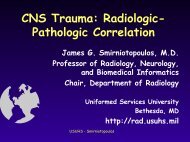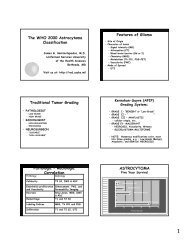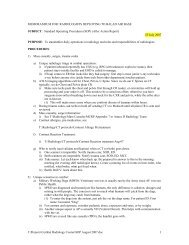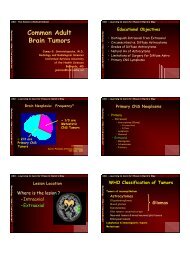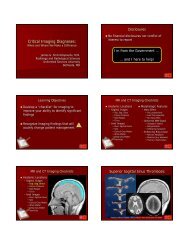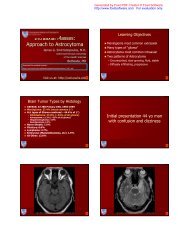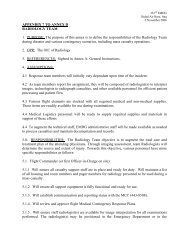Radiology Clerkship Curriculum & Site Specific Contact Information
Radiology Clerkship Curriculum & Site Specific Contact Information
Radiology Clerkship Curriculum & Site Specific Contact Information
Create successful ePaper yourself
Turn your PDF publications into a flip-book with our unique Google optimized e-Paper software.
c) Diagnose the types of cervical spine injuries and their mechanisms<br />
d) Categorize which fracture types are stable versus unstable<br />
8) Traumatic Brain Injury<br />
a) Identify which patients needs brain imaging<br />
b) Select what type of brain imaging is needed<br />
c) Differentiate between extraaxial lesions and intraaxial lesions<br />
Trainee Competencies*<br />
*Adapted from Alliance of Medical Student Educators in <strong>Radiology</strong> (AMSER)<br />
Student Competencies in<br />
<strong>Radiology</strong>. http://www.aur.org/Affiliated_Societies/AMSER/amser_curriculum.cfm<br />
P A T I E N T C A R E C O M P E T E N C I E S<br />
The trainee (medical student/intern) should provide patient care that is safe,<br />
compassionate and effective in the diagnosis and management of common<br />
health problems.<br />
GOALS<br />
1. Diagnostic management skills<br />
a. Know how to order appropriate imaging tests<br />
i. Utilize the ACR (American College of <strong>Radiology</strong>)<br />
Appropriateness Criteria<br />
ii. Include patient variables into imaging selection<br />
b. Understand the importance of providing appropriate information on the<br />
radiology request form (history, physical, risk and limiting factors) so<br />
radiology can perform appropriate modality selection, protocoling, and<br />
interpretation<br />
2. <strong>Information</strong> retrieval skills<br />
a. Know how to access images and view them<br />
i. Understand the basics of a PACS workstation<br />
ii. Understand windows, levels, image linking, etc.<br />
b. Know how to access imaging reports: preliminary and final<br />
c. Perform effective, rapid clinical information search<br />
3. Visual interpretative skills<br />
a. Know basic radiological anatomy<br />
b. Understand the factors that affect image appearance and quality<br />
c. Understand the importance of using prior comparison studies




